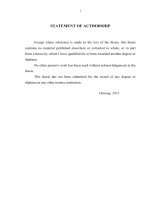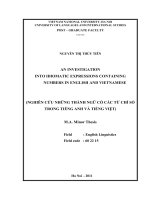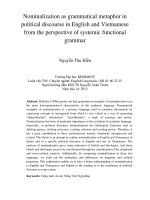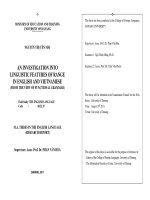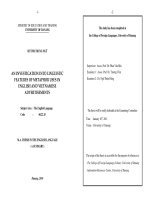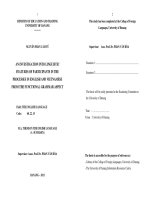An investigation into linguistic features of range in English and Vietnamese (from the view of functional grammar)
Bạn đang xem bản rút gọn của tài liệu. Xem và tải ngay bản đầy đủ của tài liệu tại đây (138.05 KB, 13 trang )
-1-
-2The thesis has been completed at the College of Foreign Languages,
MINISTRY OF EDUCATION AND TRAINING
UNIVERSITY OF DANANG
DANANG UNIVERSITY
Supervisor: Assoc. Prof. Dr. Phan Văn Hòa
NGUYỄN THỊ YẾN MAI
Examiner 1: Ngũ Thiện Hùng, Ph.D.
AN INVESTIGATION INTO
LINGUISTIC FEATURES OF RANGE
IN ENGLISH AND VIETNAMESE
Examiner 2: Assoc. Prof. Dr. Trần Văn Phước
(FROM THE VIEW OF FUNCTIONAL GRAMMAR)
The thesis will be defended at the Examination Council for the M.A.
Field Study: THE ENGLISH LANGUAGE
Code
:
60.22.15
theses, University of Danang.
Time: August 30th 2011
Venue: University of Danang
M.A. THESIS IN THE ENGLISH LANGUAGE
(RESEARCH REPORT)
Supervisor: Assoc. Prof. Dr. PHAN VĂN HÒA
The original of this thesis is accessible for the purpose of reference at:
- Library of the College of Foreign Languages, University of Danang.
- The Information Resources Center, University of Danang.
DANANG, 2011
-1-
-2-
CHAPTER 1
INTRODUCTION
1.2.2. Objectives of the study
- To find out the linguistic features of Range in processes from
1.1. RATIONALE
the view of functional grammar.
Fundamental language is essentially a natural grammar, in the
sense that everything in it can be explained.
In the fields of
functional grammar, significant studies that should be named are An
Introduction to F.G by Halliday (1994), etc.
In Vietnamese, Ngữ pháp kinh nghiệm của cú Tiếng Việt: Mô
tả theo quan ñiểm chức năng hệ thống và Dẫn luận ngữ pháp chức
năng by Hoàng Văn Vân (2000) puts forwards guidelines of
Functional Grammar. Have a look at the following examples:
- To identify more new features of word classes, especially the
relationships between verbs and nouns taking part in the processes of
communication.
- To discover the similarities and differences of Range in
English and Vietnamese.
- To increase knowledge of the relationship between semantics
and syntactics when participating in communicative functions.
- To suggest some implications for teaching, learning and using
(1) She sang a song
languages.
(2) They are climbing the mountain
1.3. THE SCOPE OF THE STUDY
(3) Thầy Năm chơi cờ.
(4) Cô ả cười một cái cười hết sức lẳng lơ.
Through those examples, we can see that in traditional
grammar, people think that they are Objects, but it is not always true.
They are the elements that specify the range or scope of the process
and specify part of the process that is not affected by the processthey are Range. For this reason, I choose to do research on the topic
“An investigation into linguistic features of Range in English and
Vietnamese”
with the hope that the research result will help
language users identify more new features of word classes, especially
the relationships between verbs and nouns taking part in the
The study focuses on investigating linguistic features of Range
in English and Vietnamese. From that, it points out some active
functions of Range in the processes.
1.4. RESEARCH QUESTIONS
1. What are the linguistic features of Range in the processes
from the view of Functional Grammar?
2. What are the linguistic features of verbs with Range
participant in the processes?
3. What are the similarities and differences of Range in English
and Vietnamese?
4. What are some implications of the study to teaching,
processes of communication.
learning and using languages?
1.2. AIMS AND OBJECTIVES
1.5. THE SIGNIFICANCE OF THE STUDY
1.2.1. Aims of the study
- To provide an in-depth analysis of Range in English and
Vietnamese.
To some extent, this research will be useful to language users
in distinguishing syntactic functions as well as semantic roles of
elements in sentences. The findings of the research will also help
-3language learners determine the importance of Grammar among
grammatical paradigms in an attempt to make functional closer to
Vietnamese study.
1.6. DEFINITION OF TERMS
16.1. Participant: A participant is realized in the grammar of
a clause by nominal group or prepositional phrases. It can be a
person, a place or an object. A participant was defined as the notion
of thingness. [2, p.66]
1.6.2. Participant roles: According to David Crystal [10],
participant roles are defined as follow:
• The functions that can be asbribed to people taking part in a
linguistic interaction.
• The semantic function attached to clause elements, such as
agent and recipient.
1.6.3. Process: According to Butt [4], processes are
expressions of happening, doing, saying and thinking. A process is
realized in the grammar by means of a verbal group, which is either
one word, belonging to the class verb, or a group of words with a
class verb word as the head or nucleus of the group.
1.6.4. Range
• According to Halliday [12], “The Range is the element that
specifies the range or domain of the process. In a “material”, the
Range is the Scope, in a “behavioral” clause, the Range is the
Behaviour”.
• According to Martin [14], “The range is the element that
elaborates or enhances the process.
1.7. ORGANIZATION OF THE STUDY
-4CHAPTER 2
LITERATURE REVIEW AND THEORETICAL
BACKGROUND
2.1. A REVIEW OF PREVIOUS STUDY
Up to now, there have been several linguists studying the
Range such as Halliday, Butt, Eggin, Martin, Thompson, etc.
In Vietnamese, Range is also a matter of concern to several
linguists such as Hoang Van Van, Phan Van Hoa, etc. They give a
detailed presentation of Range, – its definition, roles and
classifications through a number of examples.
In addition, there are some master theses carried out such as An
Investigation into Distinguishing Features between Material and
Mental Processes in English and Vietnamese by Nguyen Thi Xuan
Thuy (2007),etc. It has been found that in the previous crosslinguistic studies, the features of Range have not been explored and
studied in depth.
2.2. THEORETICAL BACKGROUND
Some fundamental theoretical knowledge related to the study:
metafunstions, the system of transitivity, process types and
associated participants and overall view about Range.
Here are the main points which are presented in this part:
2.2.1. Metafunctions
2.2.1.1. Ideational Metafunction
2.2.1.2. Interpersonal Metafunction
2.2.1.3. Textual Metafunction
2.2.2. The grammar of experiential meaning.
2.2.2.1. Process, Participant and Circumstance
2.2.2.2. Process types and associated participants
a. Material Processes
-5-
-6-
b. Mental Processes
Actor + Process + Goal or Actor + Process + Range
c. Relational Processes
d. Verbal Processes
- Range may be not an entity at all but rather another name for
the process.
e. Behavioural processes
In material process, it is useful to label Range more
f. Existential processes
specifically as either “Range: entity” or “Range: process”. Have look
2.2.3. The framework of Range
at the examples:
[1]
CHAPTER 3
METHODS AND PROCEDURES
3.1. RESEARCH DESIGN AND RESEARCH METHOD
A combination of qualitative, quantitative, descriptive and
comparative methods has been adopted in this study.
3.2. DATA COLLECTION AND ANALYSIS
The dormouse
crossed
the court
Actor
Process: material
Range: Entity
[12, p.194]
[2]
The whole country
is paying
a heavy price
Actor
Process: material
Range: Process
3.2.1 Data Collection
The research is carried out on 400 samples of Range in English
and in Vietnamese mainly taken from different sources of novels and
short stories.
3.2.2. Data Analysis
In this study, we would like to analyze data on the basis of the
knowledge of semantic. Then we report the results by using tables,
graphs and category lists. Finally, we interpret the results and offer
some conclusions, implications and recommendations.
CHAPTER 4
FINDINGS AND DISCUSSION
4.1. THE FEATURES OF RANGE IN THE PROCESSES FROM
THE VIEW OF FUCTIONAL GRAMMAR
4.1.1 Range in the Material process
In material process, Range is the Scope.
[12, p.194]
- Halliday [12] makes an important distinction between Goal
and Range.
Range cannot usually be probed by do to or do with.
A Range element can never a resultative Attribute added
within the clause.
A Range cannot be a personal pronoun.
A range cannot usually be modified by a possessive.
Ranges are less likely to become subjects than Goals.
A range can often be realized as a preposition phrase
4.1.2. Range in the Mental process
In a “mental” clause, the concept of Range helps to understand
the structure we have identified, that of the Senser and Phenomenon.
[3] Now the Major and his lady, ..... than was accorded to people who
wished to enjoy pleasure as well as to do duty.
[20, p.175]
-7-
-8-
4.1.3. Range in the Behavioural process
In this process, Range is considered to be Behaviour.
[4] She
Behaver
gave
a faint sight.
Pro.: behavioural
Table 4.1. Frequency of occurrence the dummy verbs in the
processes
Classification dummy verbs
[22, p.100]
Occur
Rate (%)
8
2.9
125
46
1. Do
Range
2. Make
4.1.4. Range in the Verbal process
3. Have
36
13.2
The concept of Range in this process turns out to be applicable
4. Give
48
17.6
to a “verbal” clause, in this case to the function we have referred to
5. Take
38
14
above as the Verbiage.
6. Get
6
2.2
7. Pay
6
2.2
8. Play
3
1.2
9. Put
2
0.7
[5] He
Sayer
made
Process: verbal
a defiant speech.
[12, p.294]
Verbiage/ Range
4.1.5. Range in the Relational process
Multiplicity of meanings of these verbs implies difference in
The ergative analysis of relational clauses is complex. For
purposes of simplicity, Token will be interpreted as medium and the
below:
Value as Range in all types.
[6] The room on the right
Token
is
Pro.: relational identifying
your office. [4, p.80]
Value/Range
4.2. THE LINGUISTIC FEATURES OF VERBS WITH RANGE
PARTICIPANTS IN THE PROCESSES IN ENGLISH
4.2.1. Semantic features of verbs with Range participants in
the processes in English
Semantically, the verb is empty in the context. Such these verbs
are sometimes said to be delexicalized because they have lost their
full lexical content and become almost “dummies”. We analyze more
than 250 samples of verbs in the processes, the results are presented in
table 4.1.
process types, which is to be demonstrated in the functional analysis
X0 + X1 = X
a. Do
[7] Dad
Actor
does
Pro.: material
the garden.
[20, p.28]
Range: entity
In this instance, the verb do functions as a material process.
The main participant is the Actor performing/carrying out an action,
which is embodied in the Range, either a process or an entity.
b. Make
[8] I
Actor
made
Pro.: material
a few phone calls.
[20, p.28]
Range: process
The verb make predominantly refers to performing an action
or producing an object. In this case, it acts as a transitive material
process.
Besides, make realizes a behavioural process, with the Behaver
as the main participant, and refers to the Behaver’s performance.
-9[9] Miss Amelia only made
Behavior
- 10 a smile and a blush.
Pro.: behavioral
The figure above shows that make realizing material process
has the highest percentage with 66.4%, behavioural process accounts
Range: process
[21, p.35]
In addition, the verb make also realizes a verbal process.
[10] I
didn’t make
Sayer
Pro.: verbal
any formal proposal. [25, p.90]
process, as the Senser experiences a feeling abut the phenomenon.
[11] “Between Mr Frank Churchill and Miss Fairfax? Oh! yes,
perfectly.- Why do you make a doubt of it?”
makes
Token
a good book.
Pro: relational
relational process occupies only 0.8%.
c. Have
When the verb have realizes a material process, Range could
Range
The final feature of the verb make is that it realizes a mental
[12] It
for 12.8%, verbal process (17.6%), mental process (2.4%) and
be regarded as the “name” of the process.
[13] “Couldn’t you have lunch, or maybe dinner, or lunch the day
after?” begged the girl.
[1, p.264]
In addition, the verb have functions as a mental process.
[20, p.29]
[14] I shall always feel much obliged to him, and have a great
regard for.
Value
The example above demonstrates that the verb make also
[1, p.42]
Through semantic extension, this verb have has also realized
realizes a relational process, in which one entity, the Token, equals,
the process of behaving.
has the qualities of and is identified through another, which functions
[15] Here, let's have a look at him;" .....
[27, p.155]
The verb have is also realized as a part of a verbal process.
as the Value/Range.
Frequency of occurrence of the verb make is shown in the
following chart.
[10, p.157]
Mental:
2.4%
Behavioural:
12.8%
ORDER /THANK, etc SOMEBODY ], the scope of saying being the
verbiage.
Relational:
0.8%
[16]... when Sowerberry had an order for the burial of some rich old
lady .....
Material
Verbal:
17.6%
Through semantic extension, the have has acquired the sense[ TO
Material:
66.4%
Frequency of occurrence of the verb have is shown in the
Verbal
Behavioural
Mental
Relational
Figure 4.1. Frequency of occurrence of the verb make
[6, p.34]
following chart:
- 11 Mental:
22.3%
- 12 From the samples analyzed above, the frequency of
Material:
33.3%
occurrence of the verb give is shown as follow:
Material
Mental: 6.3%
Verbal
Behavioural
Behavioural:
25%
Verbal:16.7%
Mental
Material
Verbal
Verbal: 19.4%
Behavioural
Mental
Figure 4.2. Frequency of occurrence of the verb have
The result of the figure of the verb have shows that material
process also occupies the highest percentage with 33.3%, the second
rank is behavioural process with 25%, mental process takes 22.3%
and the lowest percentage is verbal process with 19.4%
d. Give
The verb give also functions as a material process, verbal
process, behavioural process, and the function of the verb give in
each process is similar to the verb make, have,.. For examples,
Give functions as a Material process
[17] ...He
Actor
gave
Pro.: material
a peculiar knock. [25, p.214]
Range: Process
Give functions as a Behavioural Process
[18] He was to see the beautiful heiress ...and give chase and rescue
her.
[25, p.78]
Give functions as a Verbal Process
[19] Miss Crawley
Sayer
gave
Pro.: verbal
a final scream... .
[27, p.98]
Range
Give functions as a Mental Process
[20] The news which that famous Gazette brought to the Osbornes
gave a dreadful shock to the family and its chief.
[21, p.213]
Behavioural:
50%
Material:
27%
Figure 4.3. Frequency of occurrence of the verb give
As can be seen from the chart, the verb give realizing
behavioural process accounts the highest rate (50%), the next is
material processes (27%), verbal process takes 16.7%, mental
process has the lowest rate (6.3%)
e. Take
The verb take functions as a transitive material process in the
sense perform something, with the following example:
[21] They
took
their seats amidst a crowd of watchers.
Actor Pro.: material Range
[25, p.81]
Take also realizes a behavioural process in the following
example
[22] Catherine
took
a shy look at
Behaver
Pro.: behavioural
Range
him, expressing small admiration.
[3, p.188]
When combining with a noun of manner, take realizes a
mental process, with the Senser as the main participant, refers to the
Senser’s feeling.
[23] “... let us take all the risk and do all the fighting. [21, p.170]
As a verbal process, the verb take is used in the sense [TELL
SOMETHING] or expression of refusal, etc.
[24] “Yes, our good Mrs Elton. ... She would not take a denial.
[1, p.287]
- 13 The frequency of occurrence of the verb take is shown in this
chart:
Verbal:
10.5%
- 14 Mental:
25%
Mental: 2.6%
Material:
50%
Material
Behavioural
Mental
Material
Behavioural
Verbal
Behavioural:
25%
Mental
Behavioural:
31.6%
Material:
55.5%
Figure 4.5. Frequency of occurrence of the verb get
As the figure shows, the verb get only realizes three processes:
Figure 4.4. Frequency of occurrence of the verb take
From the figure, it can be concluded that material process takes
55.5%- the highest rate, behavioural process occupies 31.6%, verbal
process accounts for 10.5%, mental process has the percentage of
material process, behavioural process and mental process, in which
material process takes the highest rate with 50%. Mental process and
behavioural process have the same rate with 25%.
g. Pay
[28] Dorian doesn’t pay any attention to what Lord Henry says.
2.6%.
[25, p.24]
f. Get
Similarly in the verbs above, the verb get also realizes a
Lexically and grammatically, the structure resembles a clause with a
material process, in the sense of performing an action.
[25] They’re bandits, they are the ones who got possession of the
temples ....”
[10, p.280]
Get also functions as a behavioural process in the sense of
Goal, but the semantic evidence suggests that any attention is Range.
Besides, the verb pay also realizes a behavioral process.
[29] Upon my word, Dorian, Miss Sibyl knows how to pay
compliments.
behaver’s performance.
[26] .... She certainly musta got a good look at me.”
In this example, the verb pay realizes a material process.
[10, p.292]
Furthermore, it also acts as a mental process, referring to the
Frequency of occurrence of the verb pay is shown as follow:
Behavioural:
16.7%
sense [EXPERIENCE].
shown in following chart:
Mental
Behavioural
[27, p.156]
Frequency of occurrence of the verb get can be generally
Material:
50%
Material
[27] She takes to nursing real natural, and an't never better suited
than when she gets a sick body to tend.
[25, p.65]
Mental:
33.3%
Figure 4.6. Frequency of occurrence of the verb pay
- 15 -
- 16 -
The figure shows that the matrial process ranks first with 50%,
With the result from the chart, we can see that: ranking top is
mental process holds 33.3% and behavioural process appears with
Material process with the 142 samples – 52.2%; at the second high
the rate of 16.7%
percentage is Behavioral process (25%); Verbal process accounts for
h. Play
15.4%, Mental process occupies 7% and Relational process accounts
[30] That is no fun. I said. “let’s play prisoner circle”
[26, p.14]
In this case, the verb play realizes a material process. The
verb play is also interpreted as perform, the object of the verb
functions as Range, and names the performed process.
small rate in the total for only 0.4%. Especially, in this chart, there
are not any samples of Existence process.
4.2.3. Cognate features between verbs and nouns in the
processes with Range participant in English.
i. Put
Another feature of process Range is what is called in
[31] Anyway, I would put a stop to this usurpation of my time.
traditional grammar Cognate objects.
[19, p.68]
[32] When we were outside, ..., and put the questions as casually as
I could.
[19, p.72]
In the first example, the verb put realizes as a material
X1 + X2 = X
Here the object of the verb is derived directly from the verbal
meaning itself.
[33] The boy laughed a high, embarrassed laugh. (Behavioural)
process, in the sense [PERFORM SOMETHING]. On the other
[22, p.100]
hand, in the second, the verb put realizes a verbal process, in the
In this case, the head of the noun group realizing Range (laugh)
sense[ASK SOMEBODY SOMETHING].
is related to verb group head realizing the process (laughed).
In short, after analyzing more than 250 samples of verbs, the
distribution of the dummy verbs in the processes in English is shown
as below:
X1 – X2 (V
N)
[34] I think independent thought. (Mental)
[12, p.250 ]
One more important feature is that the nouns are not related to
the verbs in form, in other words, they are different in form, but are
Mental: 7% Relational: 0.4%
Verbal:
15.4%
related in meaning.
Material
Behavioural
Verbal
Mental
Relational
Behavioural:
25%
Material:
52.2%
Figure 4.7. Frequency of feature of dummy verbs in the processes
in English
X1 – X2 (V ≠ N)
[35] “Sir?” I asked, not quite sure whether he was making a statement
or asking a question. (Verbal)
[9, p.62]
The analyses of these examples demonstrate that almost
cognate objects appear in material process, behavioural process,
verbal process and mental process.
- 17 -
- 18 -
4.3. THE FEATURE OF OBJECTS IN THE PROCESSES WITH
RANGE
[36] We must have walked three miles.
classified by:
[22, p.104]
That example shows that with material processes of movement,
where the “Object” encodes the distance of the location.
[37] And he crossed the square, .........
[21, p.66]
In this example, the object square encodes the location of the
movement.
(a) Existential Range: Thủ trưởng ñã ra quyết ñịnh.
[49, p.243]
(b) Expanding Range, including:
- Elaborating Range: Thầy năm chơi cờ.
[49, p.244]
- Extending Range: Quân ñược ñiểm tốt.
[49, p.244]
- Enhancing Range: Họ vượt rào.
[49, p.244]
According to the second view, Range can be divided into two
The next step to see that certain “Objects” are an extension of
the verb. Have look at these following example:
[38] The boy was singing a wordless song.
According the first view, Range in Vietnamese can be
kinds: Independent Range and Dependent Range
Independent Range
[22,p.104]
We can therefore see the Range basically as the label given to
a nominal group which works together with the verb to express the
[41] Thằng Quân ñang leo cây.
[49, p.246]
[42] Châu á nhỏ buông một câu tiếng Anh lơ ñãng.
[42, p.379]
[43] Anh biết vị vợ nói dối, chực nói, nhưng lại thôi, buồn rầu
buông một tiếng thở dài.
process.
[35, p.11]
One more important feature of the object should be considered
In the first example, the verb “buông” functions as Verbal
is how the function of Range and the meaning is. Have a look at
process, in the sense of SAYING. In contrast, the verb “buông” in
these examples:
the second example realizes as a Behavioural process, in the sense of
[39] Tom plays the leader.
[37, p.144]
[40] Some of his friends said he could not play the violin very well.
BEHAVING. Thus, it can be concluded that one verb in Vietnamese
also appears in many process with the different functions.
Logical-semantic relationship with processes
Other example of Range in Vietnamese is illustrated as follow:
[44] Trên gương mặt cương quyết của Pha cũng chảy ra hai
dòng nước mắt trong veo.
[38, p.174]
Dependent Range
One important criterion used to determine Dependent
Range is that it can be realized by a cognate object.
The important feature in this kind is that the Range is
accompanied with Epithet, which indicates quality of the
subject, for example:
Special features to distinguish between range classes
[45] Răng bác vừa nhe ra ñể cười một cái cười do dự.
[26, p.1]
These two instances show that the leader, the guitar are
functioned as Range. The feature of Range here is Scope; however,
the meaning is totally different. The leader is Identifier, whereas, the
guitar is Tool.
4.4. THE LINGUISTIC FEATURES OF RANGE IN VIETNAMESE
Range in Vietnamese can be divided according to two different
ways:
[35, p.142]
- 19 -
- 20 -
Furthermore, the Range is also accompanied with Classifier,
4.5.1. Similarities
which indicates a particular subclass of the thing in question and this
is shown in the following example:
Firstly, in both languages, Range can be found in a process
with two participants:
[46] Những nghệ nhân già có giọng ca vút cao cất tiếng hát một bài
dân ca thật cổ hòa theo.
[29, p.13]
Actor + Process + Range
[47] When they dance I sit and play the piano very demurely.
The examples above illustrate that cognate objects in
Vietnamese also appear in some processes, such as material process,
[21, p.60]
[48] Hình như bấy nhiêu người ñêu nhận ra ông Phó Sứ là ñáng mặt
làm ..., người ta ñều ngâm ñi ngâm lại câu thơ thả. [48, p.112]
verbal process, behavioural process and mental process.
4.5.
COMPARISON
OF
RANGE
IN
ENGLISH
AND
VIETNAMESE
Secondly, Range in English, as well as in Vietnamese, is less
likely to become Subject than Goals.
Table 4.2. Frequency of occurrence of dummy verbs in the
processes in English and Vietnamese
Processes
Thirdly, from table 4.2, it can be seen that some dummy verbs
in English appear to be similar to those in Vietnamese. They both
realize some processes, such as material, behavioural process, etc.
In English
In Vietnamese
Material
+
+
Let’s look at the following examples:
Verbal
+
+
[49]
Behavioural
+
+
In English
In Vietnamese
Mental
+
+
- make a mistake
- mắc một sai lầm
Relational
+
-
Finally, morphological, some Ranges in both languages are
Existential
-
-
related to the verb and these are traditionally termed Cognate objects.
Look at these examples: - She slept a deep sleep
50%
45%
40%
35%
30%
25%
20%
15%
10%
5%
0%
- Ông ta chết một cái chết thanh thản
4.5.2 Differences
English Cognate Objects
Vietnamese Cognate Objects
The first difference between two languages is the use of
“Dummy” Verbs.
Although “Dummy” Verbs appear in both
languages; nevertheless, they are used more frequently in English.
Material Behavioural Verbal
Mental
Figure 4.8: Frequency of occurrence of cognate objects in English
and Vietnamese
This is illustrated in the example below:
[50] She
Actor
has
Pro: material
dinner
Range
- 21 -
- 22 -
It is quite clear in this English Material clause, “dinner” exists
as a Range. However, to express such an idea in Vietnamese, the
On the contrary, Range in English may be not necessary to be
accompanied by an Epithet or a Classifier.
clause employed is an intransitive one, i.e with only one participant
Finally, studying the cognate features in two languages helps
without Range), not a transitive any more. In Vietnamese, we just
us realize that in Vietnamese, the “Objects” are only derived from the
say, Cô ấy ăn tối.
verb itself. Whereas, in English cognate verbs, Objects are not only
Next, in the example [44], we can use some other verbs, such
derived from the verbs but also related to the verbs in meaning. Let’s
as tuôn dòng nước mắt, tràn hai dòng nước mắt, etc. instead of the
have a look at the examples:
verb “chảy”. It is obvious that the same meaning can be expressed
[53] Has anyone you have known or heard of died a good death?
by many different verbs in Vietnamese. Therefore, in some extent, it
[12, p.193]
can be said that dummy features in Vietnamese are more abundant
[54] "It is Mrs. Sedley's coach, sister," said Miss Jemima. "Sambo,
than those in English.
the black servant, has just rung the bell; ....."
[21, p.3]
Furthermore, as can be seen from the figure 4.8, cognate
objects realizing material process in English (38.5%) are higher than
CHAPTER 5
those in Vietnamese (34.6%). Similar to verbal process, they occupy
CONCLUSIONS AND IMPLICATIONS
23.1% in English, whereas 15.4% in Vietnamese. In addition, they
5.1. CONCLUSIONS
function as mental process with 7.7% in English and only 3.8% in
5.1.1. Range is interpreted in this research as the second most
Vietnamese. On the contrary, cognate objects realizing behavioural
nuclear participant. Range is an elaboration or an extension of the
process in Vietnamese (46.2%) are higher than those in English
process. Furthermore, Range can be realized by a propositional
(30.7%).
phrase as in: I am playing bridge. I am playing Simon at the bridge.
Especially, Range comes to existence in Vietnamese only
when it is accompanied with Epithet or a Classifier.
[51] Cô ấy
Actor
cười
Pro: material
một tiếng cười
Range
của người hút thuốc lá.
[52] Tôi
Actor
ca
Pro: material
“mental”, “verbal” and “relational” clauses. In material processes, the
khàn ñục
Range is the Scope, in “behavioural” processes, the Range is the
(Epithet)
behaviour, phenomenon in the like type of mental processes,
[37, p.144]
bài ca
Range
5.1.2. Range mainly occurs in “material”, “behavioural”,
quan họ
(Classifier)
[49, p.245]
Verbiage in Verbal processes and Attribute or Value in “relational”
clauses. Through the study, we also point out that the frequency of
occurrence of Range in Material Processes is the highest.
5.1.3. The study makes a distinction between Range and other
participants- Goal with the aim of helping hearers understand more
about the Range.
- 23 -
- 24 -
5.1.4. The study also finds out the new roles of objects. It may
Secondly, determining the feature of Range in each process
encode the distance or the location of movement or they form a
helps us identify the precise relationships of linguistic elements when
semantic unit with a verb.
carrying out the function of conversing abundant experience of
5.1.5. More important, the analysis of some dummy verbs with
humans.
Range in the processes shows that in the process of communication,
Thirdly, mastering this feature is very useful to teachers. They
the multiplicity of meanings of words is seldom a hindrance. The
will know how to group the classes of verbs and help students
understanding of the message conveyed is, for the most part, assisted
understand easilier and then students can identify new features of
by many contextual indicators, both linguistic and extralinguistic.
verbs, objects and use them more effectively.
5.1.6. The relationship between the verb and the Range is lax.
5.1.7. Dummy verbs are demonstrated to be closer to the
Range.
5.1.8. Some verbs can realize as the same process, but their
Finally, this study is also very useful for those who are
interested in this field, especially the interpreters. An insight into the
features of Range in English and Vietnamese will certainly help them
solve the problem may occur when translating a clause containing or
feature is entirely different. This means that they can symbolize
dummy verbs into target language.
either “cognate” feature or “dummy” feature.
5.3. LIMITATION OF THE STUDY
5.1.9. The similarity of Range in two languages is shown in the
structure with two participants (Actor and Range)
5.1.10. Range in Vietnamese appears to be similar to that in
Due to the limitation of time, reference materials and
researcher’s
knowledge,
shortcomings
and
inadequacies
inevitable. Moreover, what is studied is quite a theoretical topic; the
English. Range also functions as Material process, Behaviuoral
study cannot avoid clumsy explanation.
process, Verbal process and Mental process.
5.4. SUGGESTIONS FOR FURTHER RESEARCH
5.1.11. There are some differences, mainly occurring in the
frequency of kinds of Range. For examples, the frequency of empty
verbs in English is higher than in Vietnamese, whereas, the frequency
of cognate objects in Behavioural process in Vietnamese seems to be
overwhelmed over those in English.
5.2. IMPLICATIONS
First of all, investigating the concept Range helps us identify
the semantic essence of linguistic elements when they participate in
syntax structures in sentences.
are
- An investigation into features of Range in Existence process
in English and Vietnamese.
- An investigation into cognate features in the processes in
English and Vietnamese.
